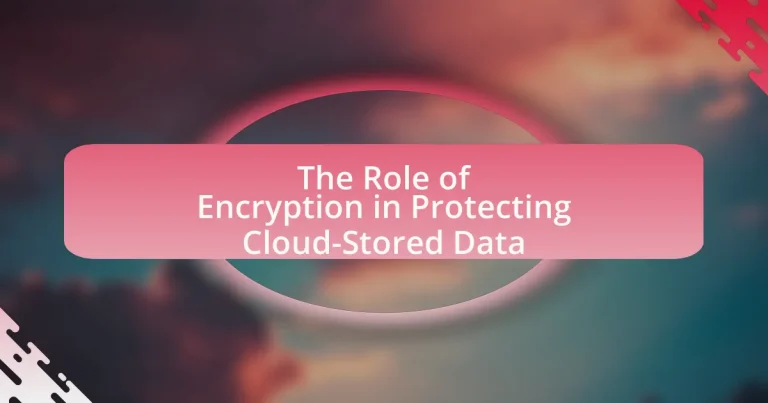Encryption is a vital security measure for protecting cloud-stored data, transforming sensitive information into an unreadable format that can only be accessed with the correct decryption key. The article explores the significance of encryption in enhancing data security, detailing various encryption methods such as symmetric and asymmetric encryption, and their roles in preventing unauthorized access and mitigating data breaches. It also addresses the challenges organizations face in implementing encryption, including key management and compliance with regulations like GDPR and HIPAA, while outlining best practices for effective encryption strategies in cloud environments.
What is the role of encryption in protecting cloud-stored data?
Encryption plays a critical role in protecting cloud-stored data by converting it into a format that is unreadable without the appropriate decryption key. This process ensures that even if unauthorized individuals gain access to the data, they cannot interpret or utilize it. According to a report by the Cloud Security Alliance, 64% of organizations cite data breaches as a significant concern, highlighting the necessity of encryption as a fundamental security measure. By implementing encryption, organizations can safeguard sensitive information, comply with regulatory requirements, and maintain customer trust, thereby reinforcing the overall security posture of cloud environments.
How does encryption enhance data security in the cloud?
Encryption enhances data security in the cloud by converting sensitive information into an unreadable format, ensuring that only authorized users can access it. This process protects data from unauthorized access during storage and transmission, significantly reducing the risk of data breaches. According to a report by the Cloud Security Alliance, 95% of organizations that implemented encryption reported improved data security. By using encryption protocols such as AES (Advanced Encryption Standard), organizations can safeguard their data against cyber threats, ensuring compliance with regulations like GDPR and HIPAA, which mandate the protection of personal and sensitive information.
What types of encryption are commonly used for cloud data protection?
Commonly used types of encryption for cloud data protection include symmetric encryption, asymmetric encryption, and hashing. Symmetric encryption, such as AES (Advanced Encryption Standard), uses the same key for both encryption and decryption, making it efficient for large data volumes. Asymmetric encryption, like RSA (Rivest-Shamir-Adleman), employs a pair of keys (public and private) for secure data transmission, enhancing security during data exchange. Hashing algorithms, such as SHA-256 (Secure Hash Algorithm), provide data integrity by generating a fixed-size hash value from input data, ensuring that any alteration in the data can be detected. These encryption methods are widely adopted in cloud services to safeguard sensitive information against unauthorized access and breaches.
How does encryption prevent unauthorized access to cloud-stored data?
Encryption prevents unauthorized access to cloud-stored data by converting the data into a format that is unreadable without the appropriate decryption key. This process ensures that even if unauthorized individuals gain access to the cloud storage, they cannot interpret or utilize the data without the key. For instance, the Advanced Encryption Standard (AES) is widely used in cloud services, providing a robust level of security by employing complex algorithms that make it computationally infeasible to decrypt the data without the correct key. As a result, encryption acts as a critical barrier, safeguarding sensitive information from potential breaches and unauthorized access.
Why is encryption essential for cloud data protection?
Encryption is essential for cloud data protection because it secures sensitive information from unauthorized access and breaches. By converting data into a coded format, encryption ensures that only authorized users with the correct decryption keys can access the original information. This is particularly important in cloud environments, where data is stored off-site and may be vulnerable to cyberattacks. According to a report by the Ponemon Institute, 60% of organizations experienced a data breach in the cloud, highlighting the need for robust security measures like encryption to protect against such incidents.
What risks does unencrypted cloud data face?
Unencrypted cloud data faces significant risks, including unauthorized access, data breaches, and data loss. Unauthorized access occurs when malicious actors exploit vulnerabilities to gain entry to sensitive information, potentially leading to identity theft or corporate espionage. Data breaches can result from cyberattacks, where attackers target unprotected data to steal or manipulate it, with the average cost of a data breach reaching $4.24 million in 2021, according to IBM’s Cost of a Data Breach Report. Additionally, data loss can happen due to accidental deletion or service outages, which can be exacerbated when data is not encrypted, making recovery more challenging. These risks highlight the critical need for encryption to safeguard cloud-stored data effectively.
How does encryption mitigate data breaches in cloud environments?
Encryption mitigates data breaches in cloud environments by transforming sensitive information into an unreadable format, ensuring that unauthorized access to data does not compromise its confidentiality. When data is encrypted, even if it is intercepted during transmission or accessed without permission, it remains protected because only individuals with the correct decryption keys can access the original content. According to a report by the Ponemon Institute, organizations that implement encryption experience 50% fewer data breaches compared to those that do not. This statistic underscores the effectiveness of encryption as a critical security measure in safeguarding cloud-stored data against unauthorized access and potential breaches.
What are the different encryption methods used in cloud storage?
The different encryption methods used in cloud storage include symmetric encryption, asymmetric encryption, and hashing. Symmetric encryption, such as AES (Advanced Encryption Standard), uses the same key for both encryption and decryption, making it efficient for large data volumes. Asymmetric encryption, exemplified by RSA (Rivest-Shamir-Adleman), employs a pair of keys—public and private—allowing secure data exchange without sharing the decryption key. Hashing, with algorithms like SHA-256 (Secure Hash Algorithm), transforms data into a fixed-size string, ensuring data integrity but not enabling decryption. These methods are essential for safeguarding sensitive information in cloud environments, as they protect data from unauthorized access and breaches.
How do symmetric and asymmetric encryption differ in cloud applications?
Symmetric and asymmetric encryption differ primarily in their key management and usage within cloud applications. Symmetric encryption uses a single key for both encryption and decryption, making it faster and more efficient for encrypting large volumes of data, which is crucial in cloud environments where performance is essential. In contrast, asymmetric encryption employs a pair of keys—one public and one private—allowing secure key exchange and authentication, which enhances security but is slower and less efficient for bulk data encryption. This distinction is significant as cloud applications often require a combination of both encryption types; symmetric encryption is typically used for data at rest due to its speed, while asymmetric encryption is utilized for secure key distribution and user authentication, ensuring that sensitive data remains protected during transmission and storage.
What are the advantages of using symmetric encryption for cloud data?
Symmetric encryption offers several advantages for cloud data protection, primarily its speed and efficiency in processing large volumes of data. This type of encryption uses a single key for both encryption and decryption, which simplifies the key management process and reduces the computational overhead compared to asymmetric encryption. Additionally, symmetric encryption algorithms, such as AES (Advanced Encryption Standard), are widely recognized for their strong security and are capable of encrypting data quickly, making them suitable for real-time applications in cloud environments. The efficiency of symmetric encryption is particularly beneficial for organizations that handle large datasets, as it allows for faster data access and retrieval while maintaining robust security measures.
In what scenarios is asymmetric encryption more beneficial for cloud storage?
Asymmetric encryption is more beneficial for cloud storage in scenarios requiring secure key exchange and data sharing among multiple users. This encryption method allows users to encrypt data with a public key, ensuring that only the holder of the corresponding private key can decrypt it. For instance, when organizations need to share sensitive information with external partners, asymmetric encryption facilitates secure transmission without the need to share private keys, thus minimizing the risk of unauthorized access. Additionally, in environments where data integrity and non-repudiation are critical, such as financial transactions or legal documents, asymmetric encryption provides a robust solution by allowing users to sign data with their private keys, ensuring authenticity and accountability.
What role do encryption keys play in cloud data security?
Encryption keys are fundamental to cloud data security as they are used to encrypt and decrypt sensitive information stored in the cloud. These keys ensure that only authorized users can access the data, thereby protecting it from unauthorized access and breaches. For instance, symmetric encryption uses a single key for both encryption and decryption, while asymmetric encryption employs a pair of keys, enhancing security by allowing public keys to encrypt data and private keys to decrypt it. The effectiveness of encryption keys is evidenced by their widespread use in compliance with regulations such as GDPR and HIPAA, which mandate the protection of personal and sensitive data.
How are encryption keys managed in cloud environments?
Encryption keys in cloud environments are managed through a combination of key management services (KMS), access controls, and encryption protocols. Cloud service providers typically offer KMS that automate the generation, storage, rotation, and deletion of encryption keys, ensuring that keys are securely managed throughout their lifecycle. For instance, AWS Key Management Service allows users to create and control encryption keys used to encrypt data, while also providing detailed access controls to restrict who can use those keys. Additionally, encryption protocols such as AES (Advanced Encryption Standard) are employed to secure data at rest and in transit, further enhancing the security of the encryption keys. This structured approach to key management is essential for maintaining data confidentiality and integrity in cloud environments.
What best practices exist for securing encryption keys in the cloud?
Best practices for securing encryption keys in the cloud include using hardware security modules (HSMs) for key management, implementing strict access controls, regularly rotating keys, and utilizing key encryption keys (KEKs) to protect data encryption keys (DEKs). HSMs provide a secure environment for key generation and storage, reducing the risk of unauthorized access. Strict access controls ensure that only authorized personnel can manage keys, minimizing the potential for insider threats. Regular key rotation limits the exposure of keys over time, while KEKs add an additional layer of security by encrypting DEKs, making it more difficult for attackers to access sensitive data. These practices are supported by industry standards such as NIST SP 800-57, which outlines key management best practices.
What challenges exist in implementing encryption for cloud-stored data?
Implementing encryption for cloud-stored data faces several challenges, including key management, performance overhead, and regulatory compliance. Key management is critical because securely generating, storing, and distributing encryption keys can be complex, especially when multiple users or systems are involved. Performance overhead arises as encryption and decryption processes can slow down data access and increase latency, impacting user experience. Regulatory compliance poses challenges as organizations must ensure that their encryption practices meet legal requirements, which can vary by jurisdiction and industry, complicating the implementation process.
How does encryption impact cloud performance and usability?
Encryption can negatively impact cloud performance and usability by introducing latency and increasing resource consumption. When data is encrypted, additional processing power is required for encryption and decryption operations, which can slow down data access and transfer speeds. For instance, a study by the International Journal of Cloud Computing and Services Science found that encryption can lead to a performance degradation of up to 30% in cloud environments due to the overhead associated with cryptographic algorithms. Additionally, usability may be affected as users may face complexities in managing encryption keys and understanding security protocols, which can hinder their ability to efficiently access and utilize cloud services.
What trade-offs must organizations consider when encrypting cloud data?
Organizations must consider the trade-offs between security and accessibility when encrypting cloud data. While encryption enhances data protection against unauthorized access, it can also complicate data retrieval and increase latency. For instance, strong encryption methods may require additional processing power, leading to slower performance. Furthermore, organizations must evaluate the balance between compliance with regulations, such as GDPR, which mandates data protection, and the potential operational overhead associated with managing encryption keys and processes. These trade-offs highlight the need for a strategic approach to encryption that aligns with organizational goals and user needs.
How can organizations balance security and performance in cloud encryption?
Organizations can balance security and performance in cloud encryption by implementing a layered encryption strategy that prioritizes data sensitivity and utilizes efficient encryption algorithms. By categorizing data based on its sensitivity, organizations can apply stronger encryption methods to highly sensitive information while using lighter encryption for less critical data, thus optimizing performance. For instance, using AES (Advanced Encryption Standard) with 256-bit keys for sensitive data ensures robust security, while employing faster algorithms like ChaCha20 for less sensitive data can enhance performance. Additionally, organizations can leverage hardware acceleration and cloud-native encryption services that optimize processing speed without compromising security, as evidenced by studies showing that hardware-based encryption can improve performance by up to 50% compared to software-only solutions.
What compliance and regulatory considerations affect cloud encryption?
Compliance and regulatory considerations that affect cloud encryption include data protection laws, industry standards, and specific regulations such as GDPR, HIPAA, and PCI DSS. These regulations mandate that organizations implement encryption to protect sensitive data both in transit and at rest, ensuring that unauthorized access is prevented. For instance, GDPR requires that personal data be encrypted to enhance security and privacy, while HIPAA mandates encryption for protected health information to comply with healthcare data security standards. Additionally, PCI DSS outlines requirements for encrypting cardholder data to safeguard against fraud. Compliance with these regulations not only helps organizations avoid legal penalties but also builds trust with customers by demonstrating a commitment to data security.
Which regulations mandate encryption for cloud-stored data?
Regulations that mandate encryption for cloud-stored data include the Health Insurance Portability and Accountability Act (HIPAA), the General Data Protection Regulation (GDPR), and the Federal Information Security Management Act (FISMA). HIPAA requires encryption to protect sensitive health information, while GDPR mandates that personal data be processed securely, which often involves encryption. FISMA establishes a framework for securing federal information systems, including the use of encryption to safeguard data. These regulations emphasize the importance of encryption as a critical measure for protecting sensitive information stored in the cloud.
How can organizations ensure compliance with encryption standards?
Organizations can ensure compliance with encryption standards by implementing robust encryption protocols and regularly auditing their encryption practices. This involves adopting industry-standard encryption algorithms, such as AES-256, which is widely recognized for its security. Additionally, organizations should conduct regular risk assessments to identify vulnerabilities and ensure that encryption methods are up to date with the latest regulatory requirements, such as GDPR or HIPAA. Compliance can be further validated through third-party audits and certifications, which provide an objective assessment of the organization’s adherence to encryption standards.
What are the best practices for encrypting cloud-stored data?
The best practices for encrypting cloud-stored data include using strong encryption algorithms, implementing end-to-end encryption, managing encryption keys securely, and regularly updating encryption protocols. Strong encryption algorithms, such as AES-256, provide robust security against unauthorized access. End-to-end encryption ensures that data is encrypted before it leaves the user’s device and remains encrypted until it reaches its intended recipient, minimizing exposure during transit. Secure key management practices, such as using hardware security modules (HSMs) or key management services (KMS), protect encryption keys from unauthorized access. Regularly updating encryption protocols addresses vulnerabilities and ensures compliance with the latest security standards, as evidenced by the National Institute of Standards and Technology (NIST) guidelines on encryption practices.
How can organizations effectively implement encryption strategies in the cloud?
Organizations can effectively implement encryption strategies in the cloud by adopting a multi-layered approach that includes data encryption at rest, in transit, and during processing. This involves utilizing strong encryption algorithms, such as AES-256, to secure sensitive data stored in cloud environments, ensuring that unauthorized access is prevented. Additionally, organizations should manage encryption keys securely, using key management services that comply with industry standards, such as NIST SP 800-57, to protect against key compromise. Regular audits and compliance checks should be conducted to ensure that encryption practices align with regulatory requirements, such as GDPR or HIPAA, which mandate data protection measures. By integrating these practices, organizations can enhance their data security posture in the cloud effectively.
What tools and technologies are recommended for cloud data encryption?
Recommended tools and technologies for cloud data encryption include Advanced Encryption Standard (AES), RSA encryption, and cloud service provider-specific solutions like AWS Key Management Service (KMS) and Azure Key Vault. AES is widely recognized for its strong security and efficiency, making it a standard choice for encrypting data at rest and in transit. RSA encryption is often used for secure data transmission, ensuring that sensitive information remains confidential. AWS KMS and Azure Key Vault provide integrated encryption management services that simplify key management and enhance security for cloud-stored data. These technologies collectively ensure robust protection against unauthorized access and data breaches in cloud environments.


